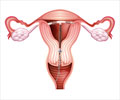Researchers have found that family planning is as effective as the contraceptive pill for avoiding unplanned pregnancies, according to a report.
Researchers have found that a method of natural family planning that uses two indicators to identify the fertile phase in a woman’s menstrual cycle is as effective as the contraceptive pill for avoiding unplanned pregnancies, according to a report.
The symptothermal method (STM) is a form of natural family planning (NFP) that enables couples to identify accurately the time of the woman’s fertile phase by measuring her temperature and observing cervical secretions. In the largest, prospective study of STM, the researchers found that if the couples then either abstained from sex or used a barrier method during the fertile period, the rate of unplanned pregnancies per year was 0.4% and 0.6% respectively. Out of all the 900 women who took part in the study, including those who had unprotected sex during their fertile period, 1.8 per 100 became unintentionally pregnant.The lead author of the report, Petra Frank-Herrmann, assistant professor and managing director of the natural fertility section in the Department of Gynaecological Endocrinology at the University of Heidelberg, Germany, said: “For a contraceptive method to be rated as highly efficient as the hormonal pill, there should be less than one pregnancy per 100 women per year when the method is used correctly. The pregnancy rate for women who used the STM method correctly in our study was 0.4%, which can be interpreted as one pregnancy occurring per 250 women per year. Therefore, we maintain that the effectiveness of STM is comparable to the effectiveness of modern contraceptive methods such as oral contraceptives, and is an effective and acceptable method of family planning.”
A number of fertility awareness based (FAB) methods of family planning have been advocated over the years, but comparisons between different methods and studies of their effectiveness have been limited and hampered by problems such as differences in cultural backgrounds, different ways to measure the effectiveness of a FAB method, different ways of classifying unintended pregnancies and other methodological problems.
“To be able to make an informed choice when selecting a family planning method, couples need to know the efficacy of a method when used both perfectly and imperfectly,” said Prof Frank-Herrmann. “We believe that this is a significant prospective cohort study that clearly defines STM and perfect and imperfect use, and which defines intended and unintended pregnancies, classifying them according to the couples’ intentions before conception.”
The researchers selected data from a cohort of 900 women who were part of a much larger study of 1,599 women using STM, which was conducted by the German Natural Family Planning study centre between 1985 and 2005. The 900 women provided data on 17,638 cycles to Prof Frank-Herrmann and her colleagues.
STM identifies the beginning and end of a woman’s fertile period using two measurements (body temperature and cervical secretions) in order to have a double-check system. The first fertile day is when the woman first identifies either: 1) first appearance or change of appearance of cervical secretion, or 2) the sixth day of the cycle. After 12 cycles, this second guideline is replaced by a calculation that subtracts seven days from the earliest day to show a temperature rise in the preceding 12 cycles, in order to identify the first fertile day. The woman is then in her fertile period. The fertile phase ends after the woman has identified: 1) the evening of the third day after the cervical secretion peak day, and 2) the evening when the woman measures the third higher temperature reading, with all three being higher than the previous six readings and the last one being 0.2 degrees C higher than the previous six.
Advertisement
Every month the women in the study sent charts to the researchers that showed their cycles, their observations of temperature and cervical secretions, and that recorded their sexual behaviour and family planning intentions for the next cycle.
Advertisement
The authors were surprised by the relatively low rate of unintended pregnancies (7.5%) among women who had unprotected sex during their fertile period. “If people are trying for pregnancy you expect a pregnancy rate of 28% per cycle,” said Prof Frank-Herrmann. “Therefore, we think that some of the couples were practising conscious, intelligent risk-taking, and were having no unprotected sex during the few highly fertile days, but had unprotected intercourse on the days at the margins of the fertile time when the risk of pregnancy was lower.”
Some studies have suggested that women’s libido is higher during their fertile period, and this could be one of the reasons why NFP methods traditionally have had a reputation for being less effective than other methods of family planning. However, Prof Frank-Herrmann said: “There are studies that suggest that this is only the case for a small proportion of women, and that, in fact, women also identify other parts of their cycle with increased sexual desire. Most women who use FAB do not find this a problem. It’s possible that the increased libido may be one of the reasons that some of the couples in our study used a barrier, such as a condom, in the fertile phase.
“This is the first time that a large, prospective STM database has been established with sufficient detailed information on sexual behaviour. It enables the true method effectiveness for STM to be calculated and we found this was 0.4% per year when there was no intercourse during the fertile phase. The user-effectiveness of STM, in other words the total number of unintended pregnancies that were due to both method and user failure, was 1.8% after 13 cycles of use, and this compares very well with results from other European studies of FAB methods of family planning. The markedly good user-effectiveness rate may be explained partly by the motivation of the couples and their teachers who agreed to participate in the study,” she concluded.
Source-Eurekalert
SRM







